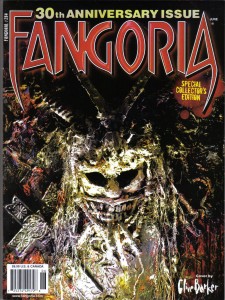 Fangoria magazine reached a major milestone this month when issue 284 hit stands. It’s been thirty years since Fango’s first issue, sporting Godzilla as cover monster of the month, was unleashed on horror fans. Fangoria is officially the longest running horror magazine in history. This is quite a feat considering the numerous problems that plagued the early days of the publication.
Fangoria magazine reached a major milestone this month when issue 284 hit stands. It’s been thirty years since Fango’s first issue, sporting Godzilla as cover monster of the month, was unleashed on horror fans. Fangoria is officially the longest running horror magazine in history. This is quite a feat considering the numerous problems that plagued the early days of the publication.
Fantastica, the magazine’s original name, was seen as an outlet for articles that didn’t fit Starlog’s sci-fi theme and a place to dump pieces that didn’t measure up to their editorial standards. According to Bob Martin’s editorial in Fangoria #2, something “so horrible as to be unfit for public description caused a delay in publication, as well as our change in name from Fantastica to Fangoria.” During the early years, Fangoria struggled to find an audience and could have been canceled after the first four issues. Part of the problem was the magazine’s schizophrenic nature. Horror fans could find an article or two about new fright flicks but they had to wade through articles about Dr. Who, Star Trek, dead cartoon animators, and fantasy artists no one had ever heard of then or since. No horror fan could take a horror magazine seriously if it featured Mr. Spock (issue 4) on the cover.
Two things occurred that saved Fangoria from being just a fly by night fright rag. First, the slasher boom started by the success of films like Friday the 13th and Maniac brought more fans into the horror genre. Second, editor Bob Martin was able to drop the sci-fi and fantasy elements and devote more space to horror movies. The magazine became streamlined and finally had direction. Martin’s decision to show gory photos in Fangoria made other mags like Famous Monsters of Filmland, Castle of Frankenstein, and The Monster Times look like something your dad or granddad might read. Fango became a cool, balls to the wall horror mag under Martin’s leadership.
Over the years Fangoria has survived the horror booms and busts, outlived many imitators, and given countless writers, directors, and stars a way to promote themselves to horror fans worldwide. Coverage in Fango helped Tom Savini, Linnea Quigley, Kane Hodder, Robert Englund. . .I could keep going with the names. . .become heroes and titans in the genre. Regular Fango features Monster Invasion and later Terror Teletype alerted fans to new horror films in the works. Dr. Cyclops and Nightmare Library helped horror fans decide which videos and novels were worth picking up and which ones were better left on shelves.
Fangoria has been around so long that it’s hard to imagine not seeing it on newsstands or magazine racks. Ironically, Fango has outlived the magazine that spawned it. Starlog is dead and gone, a result of being tied to the dying sci-fi genre. An unstable world economy and the rise of the internet age makes Fangoria’s future look pretty bleak. The good news is there is another horror boom, once again thanks to slashers, so there are plenty of high profile films for Fango to cover. Fangoria survived the wastelands of the 1990s when few horror films were being produced so itshould be able to survive this new crisis. With a little luck we’ll be discussing 50 years of Fangoria in two decades.

3 Responses to 30 Years of Fangoria